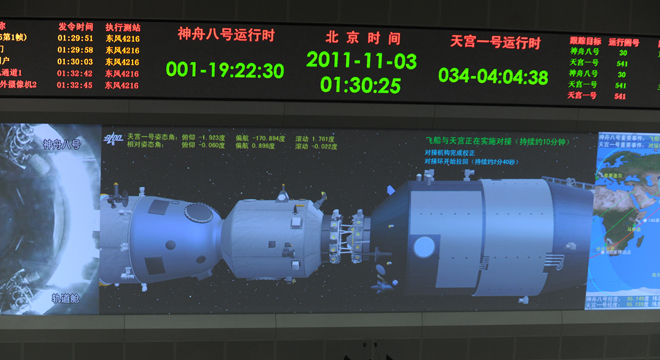China celebrated its first successful space docking on Thursday morning, a milestone in the history of human spaceflight and a critical step in the country’s ambitious plans to build its own independent space station by the early 2020s, the same decade the International Space Station is set to begin decommissioning.
The automated unmanned docking was overseen remotely from the ground by China Manned Space Engineering Office (CMSE), occurred at 1:36 am when the Shenzhou 8 spacecraft docked with the Tiangong-1 module some 213 miles above Earth, China state news outlet Xinhua reported, later saying all systems on both craft were functioning properly.
“The first rendezvous and docking mission is a great success,” read a statement on the CMSE website attributed to the agency’s chief Chang Wanquan.
China becomes the third country in the world to achieve a rendezvous and docking (but is actually the fourth body to do so, after the European Space Agency, a consortium of 18 nations, became the the third body to achieve a docking in 1998 when its Jules Verne cargo supply spacecraft linked up with the International Space Station in April 2003).
The CMSE received the congratulations of both Chinese President Hu Jintao, who is in France for the G20 summit, and the United Nations.
“Breakthroughs in and acquisition of space docking technologies are vital to the three-phase development strategy of our manned space program,” Jintao said in a statement, Xinhua reported. (Specifically, the docking procedure is phase two, after China put its first man into orbit in 2003. Phase three is the completion of the space station, the Los Angeles Times reports.)
“On behalf of the United Nations Office for Outer Space Affairs, I would like to extend to the People’s Republic of China our congratulations on the successful docking of the unmanned Shenzhou-8 spacecraft with the Tiangong space laboratory,” said Mazlan Othman, director of the UN office, adding she was “encouraged by China’s strong commitment to international cooperation in the peaceful exploration and use of outer space.”
The docking was planned to take place at night specifically to minimize the Sun’s glare on sensitive navigation instruments, according to Spaceflight Now.
Neither craft will be part of the planned Chinese space station, but are rather designed to test and perfect the docking procedures that will be necessary for the orbital assembly of the upcoming modules that will make up the station.
The Shenzhou 8 and Tiangong-1 will orbit the Earth docked together for the next 12 days, then separate to a distance of 460 feet and re-dock on November 14, this time in direct sunlight, to test the equipment’s ability to handle the glare, a CMSE spokesman told Spaceflight Now. The craft will remain linked for another two days of tests before separating for good.
Though China has rightly highlighted the moment as an independent achievement, made without help of the other two countries that have achieved an orbital rendezvous and docking, including the U.S. and Russia, the mission also includes participation from the German Aerospace Agency. The Shenzhou 8 is carrying aboard it a German scientific mini-laboratory that contains 17 experiments, including ones to expose cancer cells to the zero gravity and radiated space environment, which will parachute back to Earth aboard the Shenzhou 8 when it returns on November 17. The Tiangong-1 will remain in orbit until 2013 to conduct further docking tests, including some with human crews.
China has also pointed out that its practiced docking procedures would allow it to link up with the International Space Station, were it so invited by the two of 15 nations that lead the project, the United States and Russia. The U.S. has extended support for the ISS through 2020, and Russia reportedly wants to keep it orbiting until 2028. The U.S. government is reportedly hesitant to do anything that would assist the development of the Chinese space program due to its potential for military applications.
Over the next two years that the Tiangong-1 remains in orbit, China plans to send at least one human crewed vessel to dock with it, either the Shenzhou-9 and Shenzhou-10 spacecraft (or both). China is likely to send its first female “taikonaut” (Chinese astronaut) on one of these missions as well, and may send female taikonauts on both. There are two female taikonauts reported to be among China’s total corps of 21 astronauts (compared to the 61 NASA astronauts in 2011).
Both the Shenzhou 8, which was launched from China’s Jiuquan Satellite Launch Center on Tuesday, and the Tiangong-1, which was launched from the same outpost on September 29, are due for controlled re-entries to Earth.
But China is already working on the more advanced Tiangong-2 and Tiangong-3 and newer Shenzhou models to replace them, one of which will be used to build an orbital laboratory and allow China to practice the techniques for the construction of a completely separate 60-ton space station by the early 2020s.









